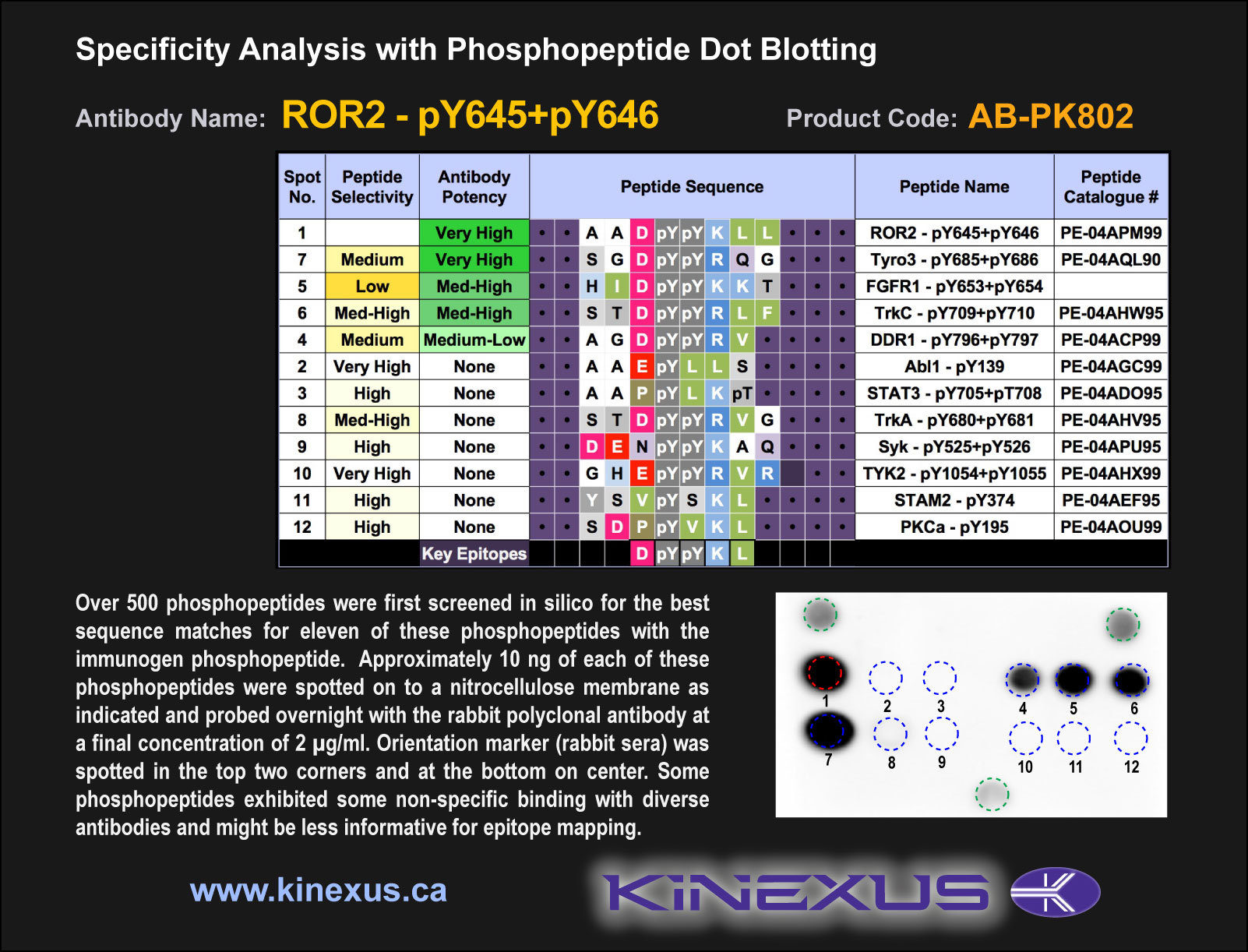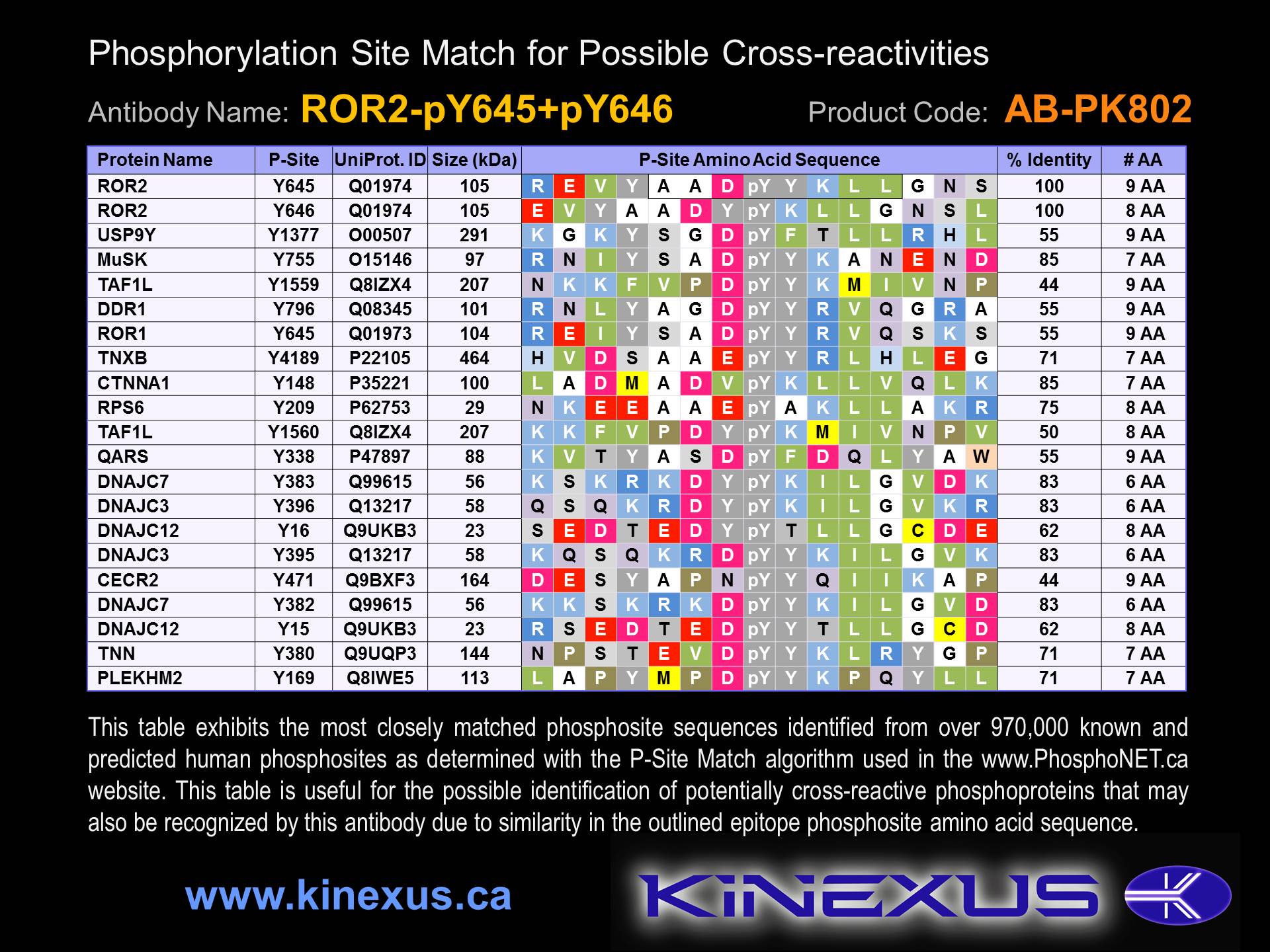Product Name: ROR2-pY645+pY646
Product Number: AB-PK802
| Size: | 25 µg | Price: | 89.00 | |
| $US |
Target Full Name: Neurotrophic tyrosine kinase, receptor-related 2
Target Alias: BDB; BDB1; MGC163394; Neurotrophic tyrosine kinase, receptor-related 2; NTRKR2; MGC163394; ENSG00000169071
Product Type Specific: Protein kinase phosphosite-specific antibody
Antibody Code: PK802
Antibody Target Type: Phosphosite-specific
Antibody Phosphosite: Y645+Y646
Protein UniProt: Q01974
Protein SigNET: Q01974
Antibody Type: Polyclonal
Antibody Host Species: Rabbit
Target Alias: BDB; BDB1; MGC163394; Neurotrophic tyrosine kinase, receptor-related 2; NTRKR2; MGC163394; ENSG00000169071
Product Type Specific: Protein kinase phosphosite-specific antibody
Antibody Code: PK802
Antibody Target Type: Phosphosite-specific
Antibody Phosphosite: Y645+Y646
Protein UniProt: Q01974
Protein SigNET: Q01974
Antibody Type: Polyclonal
Antibody Host Species: Rabbit
Antibody Immunogen Source: Human ROR2 (RON2) sequence peptide Cat. No.: PE-04APM99
Antibody Immunogen Sequence: AAD(pY)(pY)KLL(bA)C
Antibody Immunogen Description: Corresponds to amino acid residues A642 to L649; In protein kinase catalytic domain activation T-loop between subdomains VII and VIII.
Antibody Immunogen Sequence: AAD(pY)(pY)KLL(bA)C
Antibody Immunogen Description: Corresponds to amino acid residues A642 to L649; In protein kinase catalytic domain activation T-loop between subdomains VII and VIII.
Production Method: The immunizing peptide was produced by solid phase synthesis on a multipep peptide synthesizer and purified by reverse-phase hplc chromatography. Purity was assessed by analytical hplc and the amino acid sequence confirmed by mass spectrometry analysis. This peptide was coupled to KLH prior to immunization into rabbits. New Zealand White rabbits were subcutaneously injected with KLH-coupled immunizing peptide every 4 weeks for 4 months. The sera from these animals was applied onto an agarose column to which the immunogen peptide was thio-linked. Antibody was eluted from the column with 0.1 M glycine, pH 2.5. Subsequently, the antibody solution was neutralized to pH 7.0 with saturated Tris.This antibody was also subject to negative purification over phosphotyrosine-agarose.
Antibody Modification: Unconjugated. Contact KInexus if you are interest in having the antibody biotinylated or coupled with fluorescent dyes.
Antibody Modification: Unconjugated. Contact KInexus if you are interest in having the antibody biotinylated or coupled with fluorescent dyes.
Antibody Concentration: 1 mg/ml
Storage Buffer: Phosphate buffered saline pH 7.4, 0.05% Thimerasol
Storage Conditions: For long term storage, keep frozen at -40°C or lower. Stock solution can be kept at +4°C for more than 3 months. Avoid repeated freeze-thaw cycles.
Product Use: Western blotting | Antibody microarray
Antibody Dilution Recommended: 2 µg/ml for immunoblotting
Antibody Potency: Very strong immunoreactivity with immunogen peptide on dot blots.
Antibody Species Reactivity: Human
Antibody Positive Control: The observed molecular mass of the processed target protein on SDS-PAGE gels is reported to be around 100-110 kDa.
Storage Buffer: Phosphate buffered saline pH 7.4, 0.05% Thimerasol
Storage Conditions: For long term storage, keep frozen at -40°C or lower. Stock solution can be kept at +4°C for more than 3 months. Avoid repeated freeze-thaw cycles.
Product Use: Western blotting | Antibody microarray
Antibody Dilution Recommended: 2 µg/ml for immunoblotting
Antibody Potency: Very strong immunoreactivity with immunogen peptide on dot blots.
Antibody Species Reactivity: Human
Antibody Positive Control: The observed molecular mass of the processed target protein on SDS-PAGE gels is reported to be around 100-110 kDa.
Antibody Specificity: Very high
Antibody Cross Reactivity: Almost no significant cross-reactivities detected in HepG2, HeLa and T98G cells; in HepG2 cells, insulin decreases 55 kDa protein; in HeLa cells, phenylarsine oxide (PAO) increases 80 and 75 kDa proteins.
Related Product 1: ROR2-pY645+pY646 blocking peptide
Antibody Cross Reactivity: Almost no significant cross-reactivities detected in HepG2, HeLa and T98G cells; in HepG2 cells, insulin decreases 55 kDa protein; in HeLa cells, phenylarsine oxide (PAO) increases 80 and 75 kDa proteins.
Related Product 1: ROR2-pY645+pY646 blocking peptide
Scientific Background: ROR2 (NTRKR2) is a protein-tyrosine kinase of the TK group and Ror family. It is an orphan receptor kinase that is hypothesized to function in the early formation of chrondrocytes (cartilage cells) and growth plate development. ROR2 expression is generally highest during embryonic development and will gradually decrease as cells terminally differentiate. The ROR2 protein is a transmembrane protein that contains a highly conserved region of 10 cysteine residues, predicted through homology to be a binding domain for wnt ligands. Wnt5a has been identified to utilize ROR2 as a co-receptor for non-canonical Wnt signalling. ROR2 is known to phosphorylate YWHAB, which induces osteogenesis and bone formation. Therefore, the ROR2 protein is implicated in the regulation of skeletal development. Furthermore, ROR2 is also required for the migration of cells to form the mammalian palate and for the formation of filopodia in mouse embryonic fibroblasts, a requirement for cell migration. ROR2 appears to be an oncoprotein (OP). Cancer-related mutations in human tumours point to a gain of function of the protein kinase. The active form of the protein kinase normally acts to promote tumour cell proliferation. Gain-of-function mutations in the ROR2 protein are associated specifically in the promotion of the epithelial to mesenchymal transition (EMT), which is a key step during the metastasis of cancer cells. In animal studies, the injection of ROR2 deficient human melanoma cells into a mouse models results in significantly decreased cell motility and spreading as compared to cells that express ROR2, further indicating a role for ROR2 in cancer metastasis. Consequently, ROR2 is suggested to play a role in the promotion of metastasis, specifically in melanoma cells, and contributing to the progression of cancer and acting as an oncoprotein. Aberrant expression of ROR2 has been implicated in gastric, osteosarcoma, mestatic melanoma, prostate, renal cell and squamous cell carcinomas. In prostate, osteosarcomas and metastatic melanomas, Wnt5a/ROR2 receptor complex formation was implicated as the mechanism for cancer progression.
Figure 1. Epitope mapping of ROR2-pY645+pY646 antibody with similar phosphopeptides on dot blots.
Figure 2. Identification of phosphosites related to ROR2-pY645+pY646.
© Kinexus Bioinformatics Corporation 2017



